
Racing Tractors: Building a Champion
Ready to build a racing tractor that will dominate the competition? Winning isn't just about raw horsepower; it's about strategic design and meticulous engineering. This guide covers everything from optimizing power delivery to fine-tuning steering for lightning-fast turns. For more advanced techniques, check out this resource.
Harnessing the Power: Optimizing Pulley Ratios for Maximum Speed
Pulley systems are crucial for translating engine power into speed. The pulley ratio is key – smaller engine pulleys and larger driven axle pulleys increase top speed but reduce torque (the ability to accelerate quickly). Larger engine pulleys sacrifice top speed for increased torque. The ideal ratio depends on your tractor's engine, track layout, and driving style; experimentation is crucial! What's the most effective strategy for finding your ideal pulley ratio? Trial and error – test different combinations to determine what works best.
The Jackshaft: The Unsung Hero of Power Transfer
The jackshaft efficiently transfers power from the engine to the rear axle. A robust jackshaft is vital for consistent performance and prevents costly race-day breakdowns. Consider these factors:
- Placement: While center placement is common, optimal jackshaft positioning depends on your tractor's design. Experiment to find the ideal spot. What's a good starting point for jackshaft placement? Centered, but adjust based on testing.
- Materials: Steel is strong, but aluminum is lighter, potentially improving agility. The best material choice depends on your priorities – strength or lightness. What are the trade-offs between steel and aluminum jackshafts? Steel offers superior strength, whereas aluminum is lighter, enhancing maneuverability.
- Bearing Selection: High-quality bearings minimize friction, ensuring smooth operation and extended lifespan. What's the impact of using low-quality bearings? Premature failure and increased maintenance.
Steering Linkage: Precision Control for Winning Turns
Precise steering is essential for navigating tight turns at high speeds. A well-designed steering linkage ensures responsiveness and control. Consider these key elements:
- Geometry: Linkage angles dramatically impact turning radius and responsiveness. Accurate measurements and adjustments are vital. Why is precise geometry so important? Incorrect angles can make sharp turns difficult or impossible.
- Materials: Choose durable, lightweight materials to withstand the rigors of racing. What materials are best suited for a racing tractor steering linkage? High-strength steel or aluminum alloys.
- Robustness: High-quality components prevent failures during intense racing conditions.
Tire Selection: Optimizing Traction and Speed
Tire selection significantly impacts speed and traction. Experiment with different tire types and pressures to find the perfect combination for your track and driving style. Wider tires generally improve grip, enhancing stability and cornering, while narrower tires might reduce rolling resistance, leading to higher top speeds. What's the primary concern when selecting tires for a racing tractor? Balancing traction and speed.
Troubleshooting and Safety: Keeping Your Tractor Race-Ready
Safety is paramount! Regularly inspect your tractor for wear and tear, checking belts, bearings, and steering linkages before each race. Pay close attention to unusual noises or vibrations; these could signal a potential problem. Never race an unsafe machine.
Here's a table summarizing common issues and their solutions:
| Potential Problem | Possible Solution |
|---|---|
| Belt slippage | Check pulley alignment and replace worn belts; consider belt tensioners. |
| Jackshaft failure | Use high-quality components; inspect regularly and ensure proper lubrication. |
| Steering linkage issues | Check for bent or broken parts and tighten all connections; replace worn components. |
How to Optimize Jackshaft Placement for Racing Lawn Mowers
Key Takeaways:
- Pulley ratios significantly impact top speed (smaller jackshaft pulleys and larger output pulleys = higher speed).
- A jackshaft provides finer control over gear ratios compared to simple pulley adjustments.
- Careful consideration is needed for belt tension, gear ratios for varying terrain, and chassis strength.
- Transmission and tire sizes also impact final speeds.
- Experimentation is key to optimizing performance.
Understanding the Jackshaft's Role
The jackshaft acts like a gearbox, allowing precise control over speed and torque. Without it, the performance potential of your racing lawn mower is limited.
Step-by-Step Jackshaft Installation
Planning and Measurement: Carefully measure your drivetrain. Determine the optimal jackshaft placement for your desired gear ratios and consider axle location, mower deck clearance, and belt routing.
Jackshaft Fabrication: Construct the jackshaft using robust material (steel or high-strength aluminum). Precise machining is crucial for proper pulley and bearing alignment.
Pulley Selection: Select pulleys to achieve your desired gear ratios (smaller jackshaft pulley and larger output pulley = higher speed). Careful calculation of pulley diameters is essential.
Bearing Installation: Install high-quality bearings to minimize friction and maintain alignment. Proper lubrication is vital.
Belt Routing and Tension: Route belts correctly and ensure proper tension to prevent slippage (use a tension gauge).
Mounting and Securing: Securely mount the jackshaft to the mower's chassis using strong welds or bolts.
Testing and Adjustment: Test the lawn mower under various conditions and make adjustments as needed (fine-tune pulley ratios or reposition the jackshaft).
Optimizing Pulley Ratios for Maximum Speed
The relationship between pulley size and speed is inversely proportional: smaller drive pulleys and larger driven pulleys equal faster speeds. This often comes at the cost of torque, requiring careful balancing.
Troubleshooting Common Issues
- Belt Slippage: Check belt tension and pulley alignment. Consider upgrading to higher-quality belts.
- Jackshaft Misalignment: Ensure proper bearing installation and jackshaft mounting.
- Excessive Vibration: Check for loose bolts or components. Consider vibration dampeners.